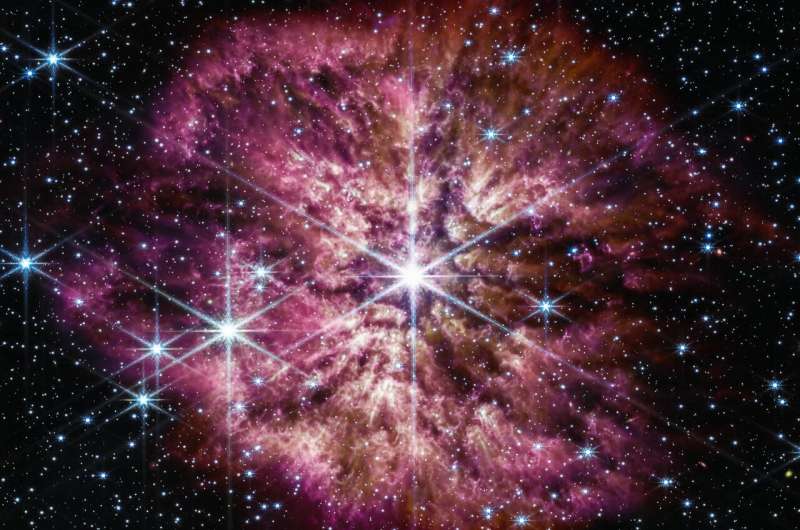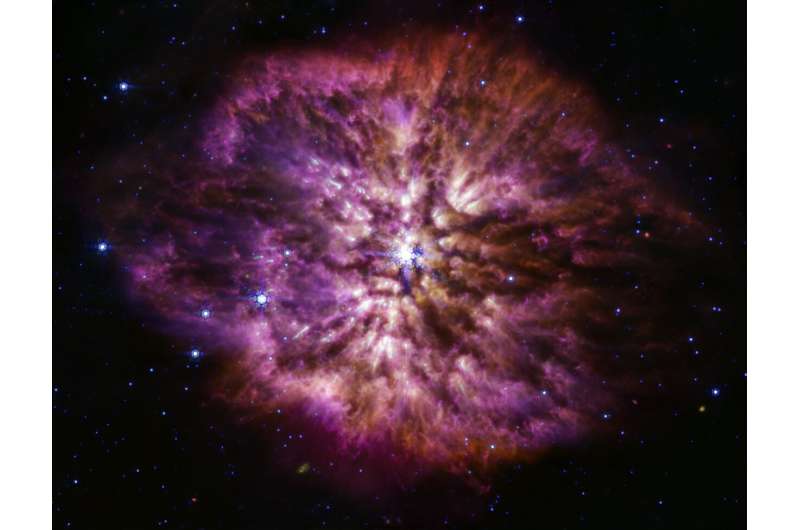This article has been reviewed according to Science X's editorial process and policies. Editors have highlighted the following attributes while ensuring the content's credibility:
fact-checked
trusted source
proofread
Webb captures rarely seen prelude to a supernova

A Wolf-Rayet star is a rare prelude to the famous final act of a massive star: the supernova. As one of its first observations in 2022, the NASA/ESA/CSA James Webb Space Telescope captured the Wolf-Rayet star WR 124 in unprecedented detail. A distinctive halo of gas and dust frames the star and glows in the infrared light detected by Webb, displaying knotty structure and a history of episodic ejections.
Despite being the scene of an impending stellar "death," astronomers also look to Wolf-Rayet stars for insight into new beginnings. Cosmic dust is forming in the turbulent nebulas surrounding these stars, dust that is composed of the heavy-element building blocks of the modern universe, including life on Earth.
The rare sight of a Wolf-Rayet star—among the most luminous, most massive, and most briefly-detectable stars known—was one of the first observations made by the NASA/ESA/CSA James Webb Space Telescope. Webb shows the star WR 124 in unprecedented detail with its powerful infrared instruments. The star is 15,000 light-years away in the constellation Sagittarius.
Massive stars race through their life cycles, and not all of them go through a brief Wolf-Rayet phase before becoming a supernova, making Webb's detailed observations valuable to astronomers. Wolf-Rayet stars are in the process of casting off their outer layers, resulting in their characteristic halos of gas and dust.
The star WR 124 is 30 times the mass of the sun and has shed 10 suns-worth of material—so far. As the ejected gas moves away from the star and cools, cosmic dust forms and glows in the infrared light detectable by Webb.

The origin of cosmic dust that can survive a supernova blast and contribute to the universe's overall "dust budget" is of great interest to astronomers for many reasons. Dust is integral to the workings of the universe: it shelters forming stars, gathers together to help form planets, and serves as a platform for molecules to form and clump together—including the building blocks of life on Earth. Despite the many essential roles that dust plays, there is still more dust in the universe than astronomers' current dust-formation theories can explain. The universe is operating with a dust budget surplus.
Webb opens up new possibilities for studying details in cosmic dust, which is best observed in infrared wavelengths of light. Webb's Near-Infrared Camera (NIRCam) balances the brightness of WR 124's stellar core and the knotty details in the fainter surrounding gas.
The telescope's Mid-Infrared Instrument (MIRI) reveals the clumpy structure of the gas and dust nebula surrounding the star. Before Webb, dust-loving astronomers simply did not have enough detailed information to explore questions of dust production in environments like WR 124, and whether that dust was of sufficient size and quantity to survive and make a significant contribution to the overall dust budget. Now those questions can be investigated with real data.
Stars like WR 124 also serve as an analogue to help astronomers understand a crucial period in the early history of the universe. Similar dying stars seeded the young universe with the heavy elements forged in their cores—elements that are now common in the current era, including on Earth.
Webb's detailed image of WR 124 preserves forever a brief, turbulent time of transformation, and promises future discoveries that will reveal the long-shrouded mysteries of cosmic dust.
Provided by European Space Agency





















